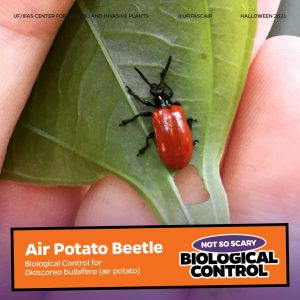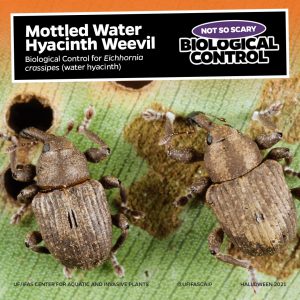While you may find some of these creatures spooky, biological control agents are not so scary after all. Biological control agents include insects, fish, or pathogens that target a specific invasive plant and increase the competitive advantage of native plants.
There is a long process of rigorous research that goes into the development of a successful biological control agent. While many candidates will fail to meet the criteria and never be released, successful agents can produce effective results.
With Halloween right around the corner, we are highlighting seven not-so-scary biological control agents that are working to protect native Florida from invasive plants. Follow along with UF/IFAS CAIP’s Not So Scary Biological Control week on Facebook, Instagram, and Twitter!
Air Potato Beetle
Target Plant: Dioscorea bulbifera (Air potato)
First released in Florida in 2012, this bright insect is the biological control agent for the invasive air potato (Dioscorea bulbifera) vine. The air potato beetle consumes leaf tissue and occasionally feeds on bulbils, negatively affecting plant growth and reproduction. In the three months after the first release, extensive damage to air potato was seen at the initial release sites of this insect. Learn more about this biological control agent in this Ask IFAS publication.
Melaleuca Leaf Weevil
Target Plant: Melaleuca quinquenervia (Melaleuca)
The melaleuca leaf weevil is a biological control agent combatting the invasive melaleuca (Melaleuca quinquenervia) tree. Adults and larva cause damage by disrupting the plants’ normal growth processes from holes or gouges chewed into the buds, leaves, and stems. Learn more about this biological control agent in this Ask IFAS publication.
Grass Carp
Target Plant: Hydrilla verticillata (Hydrilla)
Grass carp serves as a biological control agent for hydrilla (Hydrilla verticillata), an invasive plant affecting Florida’s waterways. These fish have comb-like teeth that enable them to grind vegetation. Grass carp usually reach a maximum length of 4.6 ft (1.4 m) and a maximum weight of 97 lb (44kg). The grass carp has been identified as the most effective biological control for hydrilla to date and is used nationwide. Learn more about this biological control agent in this Ask IFAS publication.
Brazilian Peppertree Thrip
Target Plant: Schinus terebinthifolia (Brazilian peppertree)
Brazilian peppertree thrips are a biological control agent for the invasive Brazilian peppertree (Schinus terebinthifolia). This insect has been studied for over 20 years and limits Brazilian peppertree growth, reduces plant height, decreases the number of green stems produced, and causes flower death. Learn more about this biological control agent in this Ask IFAS publication.
Alligatorweed Flea Beetle
Target Plant: Alternanthera philoxeroides (Alligatorweed)
The alligatorweed flea beetle is the biological control agent for the invasive alligatorweed (Alternanthera philoxeroides). This agent was the first insect ever studied for biological control of an aquatic weed. These biological control insects kill alligatorweed by destroying its stored food and removing leaf tissue, hindering photosynthesis. It has been an extremely effective biological control agent in coastal regions of the southeastern United States. Learn more about this biological control agent in this Ask IFAS publication.
Mottled Water Hyacinth Weevil
Target Plant: Eichhornia crassipes (Water hyacinth)
The mottled water hyacinth weevil is a biological control agent for the invasive water hyacinth (Eichhornia crassipes). These weevils are semiaquatic and covered with a layer of very dense, water-repellent scales. They are widespread in Florida and chew round feeding marks on the leaves and petioles causing water hyacinth plants to be weakened and their flowering and seed production to reduce by up to 97%. Learn more about this biological control agent in this Ask IFAS publication.
Questions or comments can be sent to the UF/IFAS CAIP communications manager at caip@ifas.ufl.edu. Follow UF/IFAS CAIP on social media at @ufifascaip. Read more blogs like this one on the UF/IFAS CAIP blog.
UF/IFAS Center for Aquatic and Invasive Plants. Turning Science Into Solutions.
 0
0





